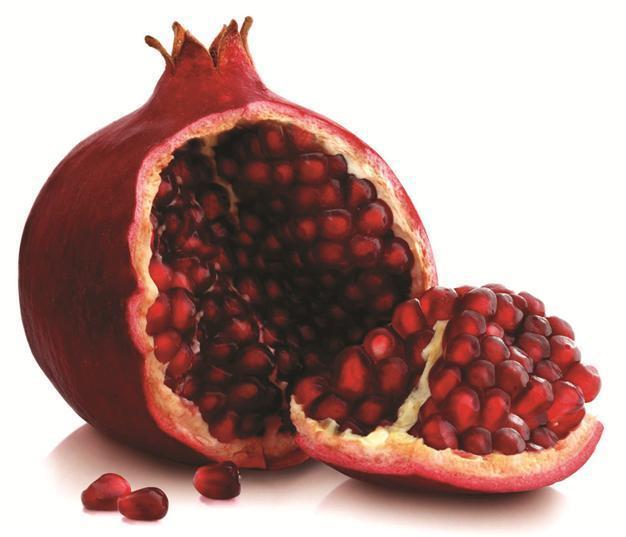One pomegranate, twelve grapes, a thousand lentils
AYLİN ÖNEY TAN - aylinoneytan@yahoo.com

What a year it has been! Turkey has been going through turmoil and our table was much flavored with peppery tear gas this year. Only a day left to step into 2014, we need an urgent fix of fate. Our change of chance for the better might well come from what we eat on New Year’s Eve.
Superstitions they are, people all over the world cannot help nibbling fortune-bringing food, even if they are complete non-believers. Certain foods are believed to bring good luck, prosperity, wealth, good health, and it is almost obligatory to have these on the table, to ensure a prosperous year. Here are my favorites, I personally will try to have them all, as I hope 2014 will be the year to move forward and to start anew.
Pomegranate must be the single food that all will agree on in this part of the world. An ancient symbol of fertility and plenty, it is customary to smash a pomegranate on the door step just as the New Year turns, a ritual observed especially by the Greek and Armenians. “One in the market, a thousand at home” is the Turkish expression that signifies the trust in pomegranates, a prosperity symbol for ages in Turkey, now also very popular worldwide; the attractive fruit has become very hip and trendy in the recent years. No festive food photography seems to exist without a few glossy pomegranate seeds adorning the food, regardless whether it’s relevant to the taste or not. A food writer friend from the Netherlands was recently complaining on Facebook that she could not stand any longer this pomegranate craze, and to my surprise she surrendered within a week or so, starting to post delightful pictures of desserts sprinkled with jewel-like ruby-colored seeds.
Fruits really cheer up a table and another one not to forget is the twelve grapes. This habit is definitely Spanish, observed also in Portugal and many Latin countries, a tradition originated in the wine-making region of Alicante almost a century ago, one has to gobble down twelve grapes when the countdown for the New Year starts. Known as “Las doce uvas de la suerte” (The twelve grapes of luck), this last minute rescue attempt is supposed to bring good luck, but if done too hastily, one can choke and need a true rescue operation. My plan is also to take twelve simultaneous sips from my champagne hoping that my spirits will be lifted by zillions of bubbles that rise to the surface, and the malign influence in my life disappears forever just like the fading fizz. After all champagne is also from grapes, so why not double-secure luck for the New Year! Though more for the Chinese New Year, one can easily nibble a tangerine or another bright orange-colored fruit, to make 2014 shine like gold.
If a single pomegranate or a dozen grapes seem too weak of an attempt to secure a year of plenty, then one has to go for numbers, and try to eat thousands of lentils, beans or wheat berries. Eating lentils is the ultimate superstition in Italy, no table can be without. Double-secured by the lucky pig, (to be precise pig trotter sausage “cotechino”), eating as many lentils as possible will bring as many coins.
In the years of the inflated Italian Lire, this seemed to be an almost useless desperate attempt to build a fortune, but now with the Euro, one can easily hope to fill a chest, or settle for a full belly at least.
Many countries use beans instead; the bean-eating Latin countries seem to have duplicated the lentil tradition of Italy. Another mythical miracle fortune food is the mighty wheat berry, so powerful in its symbolism. Bowls of sweetened boiled wheat berries will adorn many tables in Ukraine, a tradition also observed in Belarus, Lithuania, and in some parts of Poland. This classic Christmas sweet is also relevant for the New Year, with countless poppy seeds, another good-old symbol of abundance. In Russia very similar sochivo, but without the poppies, is a must to hope for a full pocket. One really believes that works, at least some of the Russians oligarchs must have observed this. The ultimate New Year wheat berry sweet in Turkey is the Armenian anush abur, very similar to ashure which is made for welcoming the first month of the Islamic New Year. The intention is similar, to start anew with good fortune, no coincidence that they’re both graced with pomegranate seeds.
To extend the table for more security one can continue in the first breakfast of the year and have
ring shaped rolls, poppy bagels, donuts or better still a Turkish simit with lots of sesame seeds, (yes another symbol of plenty) to represent the wholeness and unbroken full circle of the year coming.
Now you all know what’s going to be on my New Year Eve’s table! My wishes are no secrets but as it is considered unlucky to reveal the New Year wishes, better to keep silent and hope silence will eventually pay off. So cheers for a GOOD year, CLEAN from misfortunes of the last one, FAIR for all!
 What a year it has been! Turkey has been going through turmoil and our table was much flavored with peppery tear gas this year. Only a day left to step into 2014, we need an urgent fix of fate. Our change of chance for the better might well come from what we eat on New Year’s Eve.
What a year it has been! Turkey has been going through turmoil and our table was much flavored with peppery tear gas this year. Only a day left to step into 2014, we need an urgent fix of fate. Our change of chance for the better might well come from what we eat on New Year’s Eve.